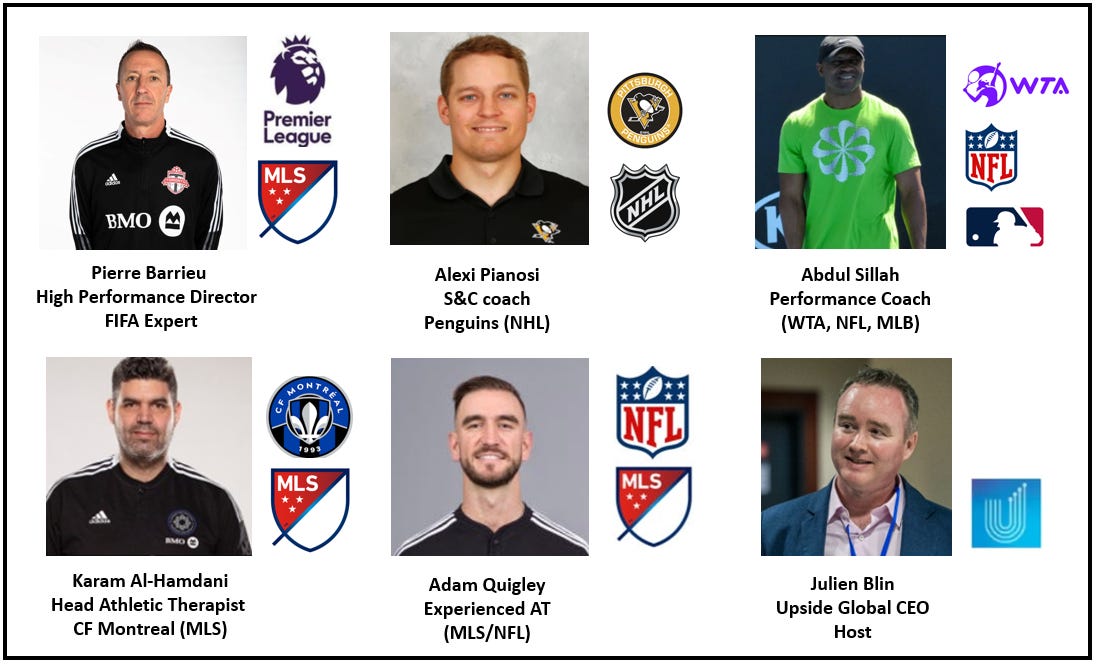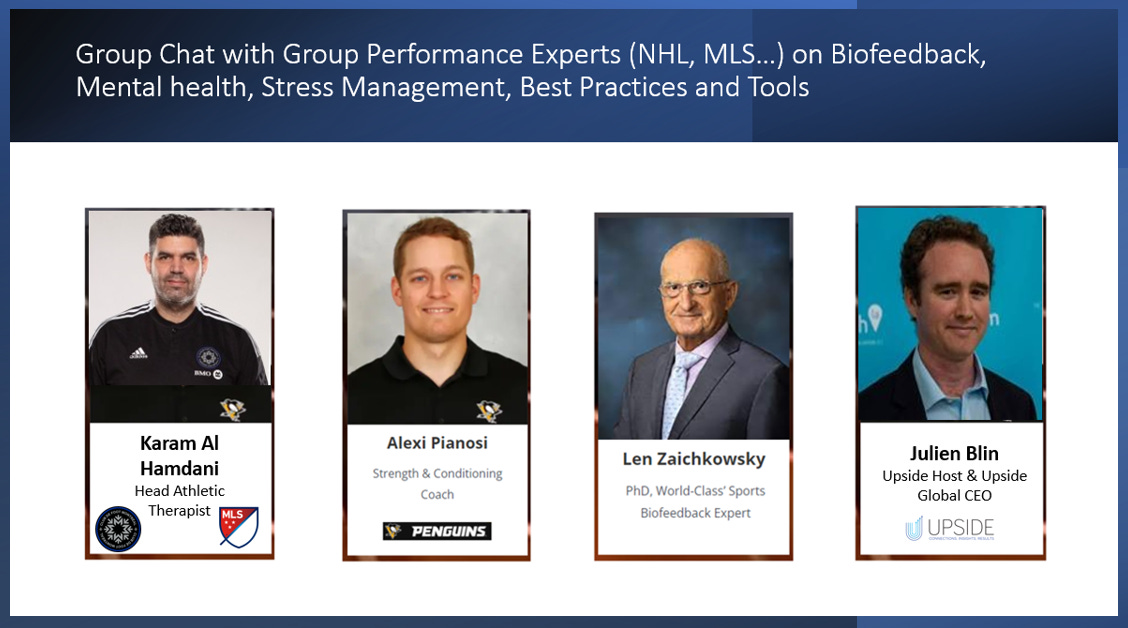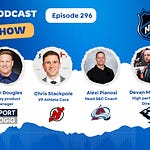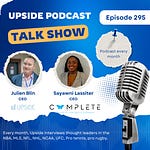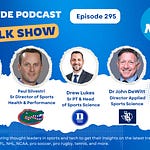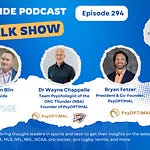This week we had the honor to interview again a group of sports performance experts.
Pierre Barrieu, an experienced high performance director in the MLS (LA Galaxy, LAFC, Toronto FC, NY Red Bulls, etc.), Premier League (Leeds United FC) and FIFA expert.
Alexi Pianosi, S&C coach for the Pittsburgh Penguins, a top NHL team.
Karam Al-Hamdani, the Head Athletic Therapist for the CF Montreal, a top MLS team.
Abdul Sillah, a world's class high performance coach...Who has worked with top athletes like Serena Williams, Naomi Osaka, Sloane Stephens or Aaron Hicks.
Adam Quigley, an experienced athletic trainer in the MLS (LA Galaxy), NFL (Saints) & US Soccer national teams.
📝Show Notes: Through this interview, we touched on the emergence of athletes hiring their own staff, athletes’ data access and ownership as well as the emergence of next gen biomarkers. We also discussed the best technologies out there that they have come across. Lastly we discussed the emergence of LiDAR based technologies, and the return of Rafael Nadal and Naomi Osaka.
🚀Best Quotes: Here are some of the key discussion points and best quotes from our conversation with Adam, Pierre, Alexi, Abdul and Karam:
On the emergence of athletes hiring their own staff (PT, chef..):
Karam Al-Hamdani:
“This has actually been something in the MLS for quite some time (..) I can talk about this because I experienced it in 2015 when we had Didier Drogba who joined our team for a year and a half. And with him joining our team came his own private Therapist along with his own chef. Now his chef was at home dealing with all the stuff at home”.
“So I can say that I did learn a great deal from from Didier Drogba’s own private therapist, and I personally think that it is here to stay”.
“As the MLS grows and as the other leagues grow and athletes make more and more money, they will start spending on themselves because they realize that this is what generates the money and they want to keep this in tip top shape”.
Alexi Pianosi:
“So I feel like it's not quite as popular of a thing in the NHL, at least during the season. In the off season for sure everybody has their strength and conditioning coach, their nutritionist, their manual therapist, soft tissue specialist, whatever you want to call them, and I think that the second layer of that question is how does that team integrate with the player's team during the season?”.
“I have seen it in at least hockey and some other sports where players' offseason coach wants them to do A, B, and C and the team wants them to do D, E, and F. And then you practice all summer to do A, B, and C and then you stink at D, E, and F when you come to the season. And then that player ends up suffering just because of a miscommunication between whether it's the coaches, the management, the therapist, the strength coaches, whoever it is”.
Pierre Barrieu:
“The more money athletes make, the more likely athletes are to have their individual staff, going back to what Karam was saying. I worked with David Beckham back in the day at the LA Galaxy and he didn't come with his strength coach or physio. That was interesting, but in England last year, I would say 40% of the Premier League players had a personal fitness coach and off”.
“The challenges are there but I think it's here to stay. I personally understand the logic behind it. I think this is the way it's going to be more and more. In my past experience, we tried to make it compatible with their private staff because the players, especially the older players, have their own habits and there are things they're not willing to compromise. So there's a lot of psychological aspects that come into play. And that's the way it's going to be”.
“Also are the private staff on site every day at the club? And if that's the case, who employs them? Do they work strictly at the player's house or a different facility? So these are the problems you run into if they're at the club or sometimes can they come to the club to use the club's facilities? So this is where the insurance chapter comes around. There are some liability issues if the athlete gets hurt during a private session outside of the club’s facility”.
Adam Quigley:
“In the MLS, it is required to have three athletic trainers, and probably one PT, so you have four people at a minimum and you have anywhere from 30 plus people on the first team”.
“And I found, from working on both sides of this, that it's very helpful from a team setting to have an outside therapist or performance coach or even an on field coach to be there to support the staff”.
Abdul Sillah:
“I actually experienced that with Aaron Hicks at the NY Yankees (MLB) (..)
So the athletic trainer and myself, the GM for the NY Yankees made sure that we had a good communication. And so, off season, the GM would call me to let me know what's going on with Aaron, and what he would like to see (..) So we had that communication”.
“ To me, that's why it's very important that we had that connection to where I was communicating with the Yankees. And sometimes I was traveling with Naomi (Osaka), and then they'll call me and say, well, Aaron is having this problem, he's not listening, he's not doing this, and then I would call him to see what's going on”.
On athletes’ data access and ownership:
Alexi Pianosi:
“I think there's definitely a bit of a split between athletes. Some love to see their data and they love to dive really deep into it and want to know all about different things. And others cannot handle even seeing how many minutes they slept last night. It gives them too much anxiety. They can't think. They can't play. So I think you'll always have those people and that's fine”.
Karam Al-Hamdani:
“What we do is we take the GPS data, we print it and we put it on a board and we have the players look at the data. As a matter of fact, it creates this camaraderie and this just fun challenge between the guys going “hey I ran more than you or I ran faster than you, et cetera. We also do the same thing from our end with all our VALD data.”
Adam Quigley:
“I've actually really appreciated some of these wearable technologies being more accessible to the general public and for the athlete to use in their own setting and the off season or a tennis athlete, for instance, training on his/her own”.
“In the past, all of the tech has been accessible within a team setting. But now having these one off chips or trackers or whatever it is for the athlete or for the practitioner to use on their own, I think, is really helpful that you don't need to be in a team setting.
“And obviously, that's for the people that choose to look into it and use it.
And then if you don't, then it doesn't really matter, but it's the accessibility and painting the picture around what the data means is really important in in either side. You have to share some information as someone shared with a GM”.
“But those GMs just don't know what the data means and they may just look at this 1 number and is it higher thinking “They're working harder”, and if it's lower they're not working hard”. So making sure the context of this information when it is shared, is a part of the picture”.
Abdul Sillah:
“In pro tennis, the coaches are typically more sensitive to the athletes’ data. And if the coaches like using the data, the athletes are going to like it. However, it depends on the athletes too. For instance, Naomi (Osaka) does not like using data. She calls it “information overload” when it comes to her. She doesn't like too much information. She doesn't want to know too much because then she starts getting anxiety and she start overthinking”.
“She's not a thinker. She just reacts. And then you have other players that I worked with such as Bianca Andreescu, who loves information. Bianca loves looking at data. She enjoys it and she reads it because she's that person. And as I said before, it all depends on the coach. You have some coaches that don't like using data. Period”.
You may also like:
🔥Upside Chat with Alexi Pianosi (Penguins/NHL), Len Zaichkowsky (NHL), Karam Al-Hamdani (CF Montreal/MLS) on Biofeedback, Stress Management, Best Practices & Tools
This week we had the honor to interview again a group of sports performance experts. Alexi Pianosi, S&C coach for the Pittsburgh Penguins, a top NHL team. Len Zaichkowsky, PhD, also known as Doc Z, an experienced biofeedback expert (NHL, NBA, Laliga..). Len is a retired Professor from Boston University and performance consultant who has worked with many e…
🔥Upside Chat with Derek Lawrance (USMNT), Jason Han (LAFC/MLS), Athanase Kollias (KINVENT), Quin Sandler (Plantiga) on Athletes' Rehab and Return to Play
This week we had the honor to interview again a group of sports performance experts. Jason Han, Head of Rehabilitation / Team Physical Therapist., LAFC (MLS team). Dr Derek Lawrance, Head Athletic Trainer, U.S. Men’s Soccer National Team. Athanase Kollias, CEO of
🔥Upside Chat with Alexi Pianosi (NHL), Dr Bill Burgos (NBA), Pierre Barrieu (MLS/EPL), Adam Quigley (MLS) on Wearables Adoption, ChatGPT/AI tools, Robotics & Stability in Pro Sports.
This week we had the honor to interview again a group of sports performance experts. Dr Bill Burgos an experienced NBA S&C coach, and adjunct professor at 2 universities: Mississippi state and Austin Peay State university. Alexi Pianosi, S&C coach for the Pittsburgh Penguins (NHL).


